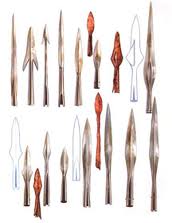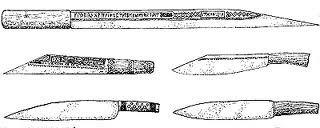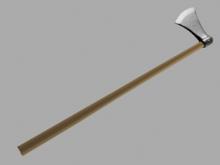
 |
|
Back to the Anglo Saxon Survival Guide Index |
Melee Weapons
We know a considerable amount about the arms and armour used by the Anglo Saxons because firstly there is much mention of them in the sagas and chronicles such as The Battle of Maldon. Secondly weapons often survive well in archaeological finds being made, at least in part, of metal such as iron and steel. So then what weapons and armour were common at the time? Firstly I will consider weapons.
Hand to Hand Weapons a) The Spear
Possession of a spear defined a freeman. A slave caught with one could expect a beating at the very least. Cheaper and simpler to make than a sword, they were therefore much more numerous. Commonly made of ash, hazel or oak with iron points and caps (ferules) these would be about 6 to 10 feet in length. A man using a spear would also hold a shield and typically fight in a shield wall with shields overlapping with his neighbours. As such a spear was used one handed. Reconstructions of fighting techniques suggested by Richard Underwood in his book Anglo Saxon Weapons and Warfare suggest two primary methods of using a spear. You can use it over arm – held up high with the arm extended and the spear pointing downwards. Used this way you could try and attack over the enemy shield against head and neck. Or you could use it underarm with the spear braced along the forearm. This was more defensive and was good for parrying the enemy spear and pushing against his shield to keep him away but was not much use offensively.
b) The Sword
Just as possession of a spear defines a freeman, owning a sword suggests a man had wealth or nobility. This is because swords take much longer to make and are much more expensive. Most Saxons swords are pattern welded. This involved starting with two to five rods of steel or iron which are formed into bars, welded together, twisted and then hammered flat. This process created strength in the final weapon. Then an upper guard, grip and pommel were attached made of wood, metal or bone. A number of swords were found with runes and markings usually identifying an owner. The balance of these weapons suggests that swords would be used to hack and chop at the foe rather than say a Roman gladius which was shorter and better used for stabbing and thrusting. Given the typical use with a shield this would be at the head, face and neck or right arm or the lower leg – all of which were not so well protected by the shield.
c) The Seax
This was actually the weapon from which the Saxons derived their name. It was a short one edged blade – really a long knife about the size of a modern large kitchen knife. This was not designed as a primary combat weapon but it seemed likely that every man and most women would carry one as it is a useful tool. There are images and mentions in sagas suggesting use in hunting such as dispatching a wounded animal. In battle it would be a last ditch weapon to be used in desperation.
d) The Axe
Long shafted and short shafted axes were tools used mainly for felling trees and working timber. Their use in battle was limited because of several draw backs. The shaft being made of wood was vulnerable to enemy swords. A man might seize the shaft and pull it out of an enemy’s hand in the way that you could not with a sword. Finally the cutting edge was much shorter than that of a sword which meant it could not cut as deep or as long. The head of an axe was however heavy and in the hands of a strong man would make a brutal weapon as evidenced by tales of a single Viking axeman at the Battle of Stamford Bridge in 1066 holding up an entire army as he stood on the narrow bridge.
Most of the material in this article is drawn from material in Anglo Saxon Weapons and Warfare by Richard Underwood.
|










